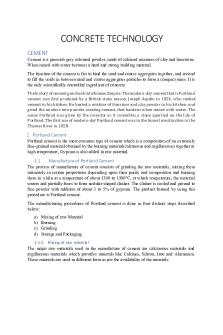Link Manufacturing Process and Product Life Cycles PDF

| Title | Link Manufacturing Process and Product Life Cycles |
|---|---|
| Author | marc sssz |
| Course | Operations Management |
| Institution | University of Bradford |
| Pages | 3 |
| File Size | 69.7 KB |
| File Type | |
| Total Downloads | 17 |
| Total Views | 176 |
Summary
Link Manufacturing Process and Product Life Cycles...
Description
Link Manufacturing Process and Product Life Cycles Introduction The product life cycle has been studied very frequently but there are sufficient theories that question the usefulness. Advantage: useful framework to think about the growth and development of a new product, company or entire industry Disadvantage: concentrates on marketing implications of life cycle process misleading in strategic planning
The Product Process Matrix Process evolution: 1. Fluid process highly efficient but not cost effective 2. Systemic process very efficient but much more capital intensive and less flexible Interaction of product and process life cycle:
Diagonal Position 1. Jumbled-flow (job shop) (e.g. commercial printer) o Each job is unique o Job shop process o Jobs arrive in different forms and require different tasks general purpose equipment 2. Disconnected line flow (batch) process o Economies of scale o Several basic models with a variety of options flow pattern 3. Connected line flow process (assembly line) (e.g. automobile industry) o Only a few models o Relatively merchandized and connected production process 4. Continuous flow refinery operations (e.g. oil processing) o Product is a commodity o Process is continuous o Highly specialized o Inflexible o Capital intensive o Low variable costs Off the Diagonal Companies might seek a position off the diagonal to gain a competitive advantage if you drift from the diagonal without knowing about the implications you may have serious troubles Potential threat: 1. Too dissimilar from competitors more vulnerable to attack 2. Makes coordination of marketing and manufacturing more difficult Advantages: 1. Encourages creative thinking about organizational competence and competitive advantage 2. More informal predictions about changes 3. Natural way of incorporating manufacturing managers in the planning process and relating them to marketing strategies...
Similar Free PDFs

CH3-Product and Process Design
- 29 Pages

PRODUCT DEVELOPMENT PROCESS
- 2 Pages

Activity - Product Life Cycle
- 1 Pages

Product Life Cycle - Assignment
- 5 Pages

Product Life Cycle
- 5 Pages

Product Life Cycle
- 2 Pages

PRODUCT LIFE CYCLE THEORY
- 12 Pages

Adidas and the Product Life Cycle
- 14 Pages
Popular Institutions
- Tinajero National High School - Annex
- Politeknik Caltex Riau
- Yokohama City University
- SGT University
- University of Al-Qadisiyah
- Divine Word College of Vigan
- Techniek College Rotterdam
- Universidade de Santiago
- Universiti Teknologi MARA Cawangan Johor Kampus Pasir Gudang
- Poltekkes Kemenkes Yogyakarta
- Baguio City National High School
- Colegio san marcos
- preparatoria uno
- Centro de Bachillerato Tecnológico Industrial y de Servicios No. 107
- Dalian Maritime University
- Quang Trung Secondary School
- Colegio Tecnológico en Informática
- Corporación Regional de Educación Superior
- Grupo CEDVA
- Dar Al Uloom University
- Centro de Estudios Preuniversitarios de la Universidad Nacional de Ingeniería
- 上智大学
- Aakash International School, Nuna Majara
- San Felipe Neri Catholic School
- Kang Chiao International School - New Taipei City
- Misamis Occidental National High School
- Institución Educativa Escuela Normal Juan Ladrilleros
- Kolehiyo ng Pantukan
- Batanes State College
- Instituto Continental
- Sekolah Menengah Kejuruan Kesehatan Kaltara (Tarakan)
- Colegio de La Inmaculada Concepcion - Cebu







